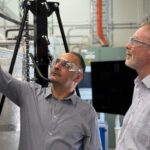C241/08
2 September 2008
Published in Science
Slamming tectonic plates beneath the Earth’s oceans have been linked to global explosions and subsequent slumps in marine life by an international team of researchers that includes Curtin University of Technology geologist, Dr Moyra Wilson. Their review paper titled “Hopping Hotspots: Global Shifts in Marine Biodiversity” appears in the latest issue of the high profile scientific journal Science.
“Hopping Hotspots” are regions containing high species diversity that have been identified as existing first in Europe, then in Africa, during the last 50 million years, with a present day “hotspot” around South East Asia and Australia.
The research team, led by Dr Willem Renema from the Natural History Museum of the Netherlands, examined fossil and molecular evidence which shows these “hotspots” are areas where marine life has exploded due to the collision of tectonic plates. Tectonic movement as two continents approach one another causes uplift of the intervening ocean floor and creates a complex area of shallow water environments that promote increases in biodiversity. With further closure of the plates, the two continents collide destroying the shallow seas and building mountain ranges that result in decreased marine biodiversity.
Dr Moyra Wilson is a Research and Teaching Fellow with Curtin’s Department of Applied Geology and the Institute for Geoscience Research. She explains how her research evaluates changes in marine richness and has helped gauge the added effect of climate change on the South East Asia – Australia “hotspot”.
“Throughout geological history we have seen strong links between tectonic plate movement and marine biodiversity. However, fossil records from the modern biodiversity “hotspot” in South East Asia have also been used to argue an additional link between coral reef formation and climate change, with decreased reefal development during periods of increased atmospheric CO2 levels” Dr Wilson said.
“We are now studying tropical reef deposits to evaluate the extent to which these biodiversity hotspots are declining as a result of man-made events as opposed to naturally occurring tectonic, climatic or oceanographic changes.”.
“The margins of tropical oceans provide excellent records of climate change as the shallow-marine reef deposits (carbonates) found in these regions are derived from a mix of marine organisms known to be highly responsive to changing environmental conditions. By evaluating changes in equatorial carbonates, we should be able to identify trends that distinguish between opposing theories of how the tropics respond to global change.”
Associate Professor Ian Fitzsimons, Head of Applied Geology at the WA School of Mines, commented on Dr Wilson’s achievement.
“Dr Moyra Wilson has worked in South East Asia for over 15 years researching changes in marine life recorded by rocks of the Cenozoic Era, a period stretching from 65 million years ago to the present day, and this knowledge made her a critical member of the research team” Associate Professor Fitzsimons said.
“Her work has important implications for the diverse reefs of South East Asia, which are amongst the most threatened at the present time.”
The team hopes its observations will help scientists understand whether biological diversity in particular locations is declining naturally due to geological changes or as a result of human activity. This is particularly relevant given current concerns over the demise of the world’s coral reefs.
Modified: 2 September 2008


